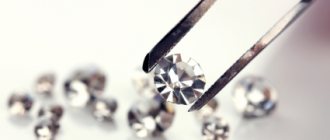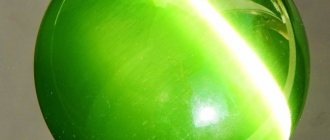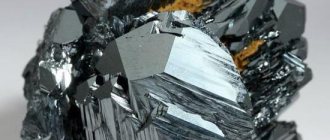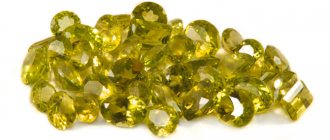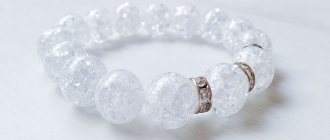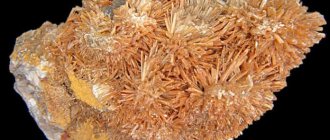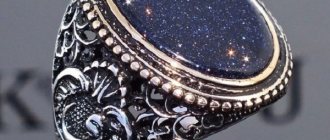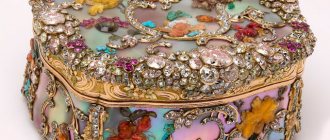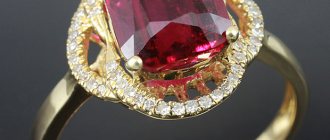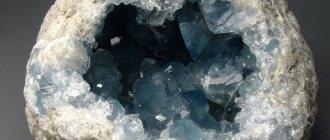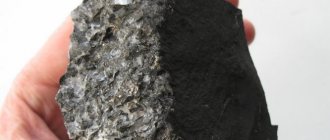Sapphires and rubies have always been considered one of the most expensive stones. They belong to the same variety - corundum, but have different colors. In addition, as it turns out, only blue sapphire belongs to the category of precious stones. When buying any of these stones, you can often run into synthetic corundum. What is he like?
Synthetic corundums
Most people assume that synthetic stones are fake. Actually this is not true. Such a stone is a complete analogue of a natural one, only grown in a laboratory. Artificial corundum in its composition is similar to natural stone in structure, optical, physical and chemical properties.
There are several methods for extracting artificial corundum that are used in industry:
- Czohalski method;
- zone melting method;
- obtaining from the gas phase;
- hydrothermal;
- from solutions in the melt.
Since each method has its own technology, the end result is different. With the help of special equipment, you can not only see that the stone is not of natural origin, but also determine the method that was used to create it.
The stone can imitate natural minerals or have shades that are not found naturally. Among natural stones, artificial corundum replaces:
- Colorless stone. Previously, it was used as an analogue of diamonds, but was later replaced by cubic zirconia, due to the fact that it had a higher refractive index and cheaper production technology.
- Red. This color of artificial stone is used instead of ruby; sometimes it can also be used to imitate garnet or spinel, but rarely.
- Dark red is used to imitate stones such as pyrope and almandine. But most often they are replaced with dark red quartz.
- Pink, a mineral of this color is used to make pink sapphires and imitations of other stones - topaz, tourmaline, beryl.
- Orange color is used to create types of sapphires - padparadscha, hessonite, and also as an imitation of hyacinth.
- Yellow. Padparadscha, as well as yellow topaz and heliodor.
- Green. Chlorosapphire, imitation emerald, chrysoberyl, demantoid.
In addition, synthetic corundum is used to create stones, which have their own trade names:
- Rose of France. Corundum is lilac-red in color.
- Damburite is a dark yellow stone.
- Rosolin - dark pink.
- Medeira topaz is yellow-brown.
- Palmyra topaz is brown.
- Amaryl - pale green.
- Burmese sapphire - blue.
Recently, high-quality rubies and sapphires with the effect of asterism have begun to be produced. In such stones, inclusions in the form of rutile crystals, which are arranged in a certain order, create a star-shaped effect with a different number of rays in the center of the stone. To simulate this effect, a molten solution is injected into titanium oxide.
In industrial settings, an ore called bauxite is used to create corundum. It is melted and then crystallized in an oxygen-hydrogen flame in electric furnaces. Furnaces also contain a reducing agent in the form of iron filings.
In order to obtain a red stone, which will later be used as a ruby, chromium oxide is used. All yellow sapphires are produced using nickel oxide.
If you add vanadium oxide during the manufacturing process, the stone will have a reddish-yellow color in daylight, and red in artificial light. The green tint is obtained by adding metals such as magnesium, cobalt and zinc. Chrome and iron produce red colors and are used to produce synthetic rubies. Titanium is used to give corundum the color of sapphire blue. And with the help of three metals together they make purple-colored stones.
To obtain a uniform color, refining methods are used that are applicable for natural corundum: diffusion and annealing. Although in fact both of these methods are based on the physical phenomenon of diffusion, simply annealing stimulates processes inside the stone. Moreover, the depth to which the color penetrates into the stone depends on the size of the dye molecule. During annealing, the entire stone is filled with color to its full depth, and during diffusion, it is partially filled. Therefore, the second method is not durable; the color may come off when the stone is re-cut and polished.
Is the mineral corundum precious?
Almost all ladies love jewelry adorned with bright sapphires and rubies.
Many people know that these gems are precious and are classified as first category stones. But not everyone knows that these same crystals belong to one group of minerals, the general name of which is corundum. Therefore, the answer to the question of whether corundum is a precious stone or not can only be answered positively. Sapphires and rubies have their own precious varieties:
Rubies are a mineral with a transparent structure, their colors range from bright, rich scarlet and cherry to pale and pinkish red. These gems have the following subspecies:
- Star-shaped;
- Siamese;
- Ceylonese.
Sapphires are nuggets that also have a transparent structure; their color range has bright cornflower blue shades, as well as lighter colors. These minerals are divided into:
- Star-shaped;
- Leucosapphires;
- Violet (oriental amethyst);
- Padparadscha;
- Chlorosapphire.
A fairly wide range of colors of stones is explained by various impurities in their chemical composition; as a rule, iron, manganese, titanium and chromium contribute to unusual colors.
When did they start creating artificial corundum?
The first artificial gems were made from ordinary glass; in rare cases, rock crystal was used for these purposes. The year 1892 was particularly successful; it was during this period that scientists managed to create a synthetic ruby. Later, this technology began to be used on an industrial scale.
Such gems are widely used today in jewelry and other fields of activity. It is worth noting that the artificial variety of the mineral is similar in its chemical composition, structure, and physical properties to a stone of natural origin.
Today, laboratories use several methods to create artificial minerals:
- Hydrothermal method;
- Czohalski method;
- By zone melting method;
- Melt solutions;
- Production from the gas phase.
Each of the above methods has its own manufacturing scheme. Moreover, the end result of each is also different. Using devices, specialists can not only find the differences between synthetic stone and natural stone, but also determine the method by which it was created.
An artificially created stone can have not only natural shades, but also have a color that does not occur in nature at all. Corundum comes in the following colors:
- Transparent. Previously used as an imitation of diamonds. Then he stopped, as they began to use cubic zirconia for this purpose.
- Orange. It is used to create imitation sapphires, such as padparadscha and hessonite. It is also used to create an imitation of hyacinth.
- Red. This color is used to create unnatural ruby, sometimes spinel or garnet.
- Yellow. This shade is used to imitate yellow topaz or heliodor.
- Dark red. This color is used to create artificial almadine or pyrope.
- Green. This shade is used to create unnatural demantoid, emerald, chlorosapphire, chrysoberyl.
- Pink. Synthetic corundum of this color is used to imitate topazes, beryls, pink sapphires, and tourmalines.
Also today, industry creates fake corundum to create minerals that have their own trademarks:
- "Rose of France" (lilac-red);
- "Burma sapphire" (blue);
- "Palmyra Topaz" (brown);
- "Damburit" (dark yellow);
- "Amaril" (pale green);
- "Madeira Topaz" (yellow-brown);
- "Rosolin" (dark pink).
Today, technologies for the production of non-natural gems have reached a new level and very high-quality synthetic sapphires and rubies have begun to be created. To create artificial corundum, an ore called bauxite is used. This material is melted and then crystallized using electric furnaces.
Red stone is obtained using chromium oxide in its creation. Yellowish sapphires are made using nickel oxide. Green minerals are obtained using zinc, magnesium and cobalt. To obtain blue sapphires, titanium is used in production.
Description of the stone
Corundums are a group of minerals. They have similar not only physical, but also chemical properties and structure. Some time ago it was believed that different species derived from corundum belonged to independent materials. But then chemistry and geology developed rapidly. And it became known that all minerals related to the same group are simply varieties of corundum.
How did the name of the stone come about? There is an assumption that the name comes from the words “kauruntaka” and “kuruvinda”, which are translated from Sanskrit as ruby.
But there is corundum without impurities, pure. The stone is very rare, so its value is high all over the world; the pleasure of wearing such a stone in jewelry is not cheap. A feature of pure corundum is its complete transparency, it has no color, and has a glassy luster. Outwardly it looks like a diamond.
The most commonly mined corundums are colored corundums due to the fact that they contain colloids that give them color. There are a wide variety of shades: blue, blue, green, scarlet, lilac. Since ancient times, red corundums have been valued as they are associated with power.
Main characteristics: physical properties, colors and chemical composition
The largest percentage of corundum is aluminum oxide. It also contains impurities of iron, magnesium, nickel, titanium and vanadium in varying proportions. Industrial corundum contains more iron, red carbuncles have more chromium, and dark blue sapphires have more titanium. Bright, pronounced shades can be achieved by technical means: irradiation or heating. These methods are often used in the production of synthetic stones.
Pure corundum is characterized by a high degree of hardness and transparency with a glassy luster. Its hardness on the Moss scale is 9 points, and the density of the mineral varies from 3.95 to 4.1 s/cm³. The melting point of the mineral is over 2030°C. The crystal is insoluble in chemical acids.
The most famous varieties of corundum are sapphires and rubies. The latter often compete in price with pure diamonds. The color range of rubies varies from dark pink to cherry red. The most expensive stones are burgundy.
There are several types of rubies:
- Star-shaped. Rare minerals. The origin of the name is closely related to their appearance. The main feature is the star, which is clearly visible on the cut of the crystal.
- Ceylonese. Rubies of an unusual shade - lilac and purple. The main place of production is Sri Lanka.
- Siamese. Thai stones are also distinguished by their unusual color and high degree of purity.
- Burmese. Natural stones “pigeon blood color”. They have the brightest fluorescent red color, which is noticeable regardless of lighting.
- Tanzanian. Rubies of the darkest shade of the guarantor. The stones mined in Songea are considered the purest in the world.
The second precious variety is sapphires. The main shade can vary from pale bluish to dark cornflower blue. A wide color spectrum provides a variety of types:
- Chlorosapphires. Green colored minerals that are often confused with emerald.
- Padparadscha. Translated from Sanskrit “lotus flower”. Stones in pink, orange and yellow shades.
- Leucosapphires. The second name is “oriental diamonds”. The main difference is the lack of color, transparency.
- Star-shaped. Crystals with the same asterism effect as rubies (a star on the cut).
- Blue. One of the rarest sapphires, distinguished by a delicate cold hue. Mined in India and Australia.
- Blue. Kashmiri stones with the purest shade of “royal” blue are considered the best in the world. Australian sapphires are characterized by a black-blue tone, while Ural sapphires are characterized by a gray-blue color.
- Alexandrite. Unique minerals that, like alexandrite, can change their color depending on the lighting.
It is also worth mentioning emery - an industrial type of corundum, which, mixed with magnetite, is used as an abrasive material.
Do you like the varieties of corundum stone? Very Not particularly
Properties
The abrasive material is characterized by:
- High strength data;
- Exceptional hardness parameters - 9 points (Mohs scale);
- Excellent fire resistance;
- Stability of properties.
Different types of mineral have different characteristics in terms of quality and purity. They have a very high melting point and are impervious to acids. The properties of the material can be adjusted at the production stage. To do this, alloying chemical additives are introduced into the melt. They significantly improve the parameters of hardness, strength, and heat resistance.
White corundum is produced in several grades - 25A, 23A, 24A, 22A. The higher the number, the higher the quality of the mineral, the percentage of aluminum oxide in it. The density of the material is from 3.9 to 3.95 g/cm3. The microhardness of the substance is from 19.6 to 20.9 GPa.
White electrocorundum grains, thanks to their sharp edges and high-strength properties, easily penetrate the hardest materials. When processing surfaces, they create less heat than other types of electrocorundum and provide excellent surface cleanliness.
Korunda Group
A group of minerals called corundum is not found in nature as often as connoisseurs and collectors of precious stones would like. And this is not surprising. After all, they include some of the most majestic gems present on Earth. A red specimen is called a ruby, while blue and cyan shades are called sapphire. There are a great many legends about these unique nuggets; historical facts confirm that corundums were in price even during the existence of the ancient world. What are these stones? What is their composition, crystal structure, where are the main deposits located? All this will be discussed below.
Chemical composition and crystal lattice of corundum
When studying the mineral at the molecular level, you can see that it is based on aluminum oxide. The chemical formula of any corundum is as follows - Al₂O₃. Almost always it contains additional substances: iron, chromium, titanium and others. However, their concentration is negligible and occupies no more than two percent of the total mass. The presence of certain chemical elements affects the color of the nugget, each of which has its own name. So, the following types of stones are distinguished:
- Ruby is a red stone, belongs to the group of precious nuggets;
- Sapphire - predominantly blue and blue specimens, are also considered a precious mineral, but are valued less than rubies;
- Padparadscha belongs to the group of fancy sapphires. The mineral has a yellow or orange color, which is possible due to iron impurities.
- Star corundum is an amazing nugget, on the surface of which you can see a shining six-pointed star. It comes in red or blue color.
- Leucosapphire is the second name for “oriental diamond”; it is a transparent mineral that is of little value;
- Common corundum is the most commonly found in nature. It is gray in color and opaque. It has physical properties similar to precious specimens - strength, fire resistance. Therefore, it is often used as an abrasive and refractory material, as well as in the production of certain types of enamel.
If you study the crystal lattice of corundum, you can see that the oxygen particles (highlighted in red in the figure) are located very tightly to each other. In this case, groups of three oxygen ions are always in contact with two aluminum particles (indicated by gray spheres in the figure). This martensitic transformation of the metal provides a very strong interweaving, due to which the crystals have a high hardness index, second only to diamonds.
The period of crystallization of aluminum oxide under natural conditions requires a huge amount of time, estimated in hundreds of years. It is important to observe the external conditions due to which the stone is formed.
According to geological studies, aluminum ranks third in its presence in the earth's crust and is second only to oxygen and silicon. The total share of aluminum is about 7%. But the proportion of corundum is much less. For its formation, many factors and environmental influences are necessary. There is still no accurate data on the amount of this mineral in the earth.
Crystal Shape
There is no exact date for the official discovery of the group of minerals. It is reliably known that it was mined back in the days of Ancient Rome and Ancient Greece. Even then, scientists used its density to create tools and its incredible beauty in the production of jewelry. But the unification of all corundums into a common group took place only in the 19th century.
The appearance of the crystals has a pyramidal, barrel-shaped or columnar shape. Moreover, the size of each individual sample can reach 10 centimeters in diameter. Most often in nature, corundum is found in the form of inclusions in another rock. And getting a whole, undeformed specimen is quite a difficult task. The described nugget never forms in geodes.
Crystallographic characteristics
syngony L33L23PC.
The class is ditrigonal-scalenohedral.
Crystal structure
Al atoms are located in the octahedral voids of the hexagonal closest packing of O atoms according to the “corundum” motif
- Al atoms fill 2/3 of the octahedral voids). The octahedral layers are superimposed on one another in such a way that there are columns of octahedra elongated along the c axis.
- two filled octahedra alternate with unfilled ones.
It is the only natural modification of alumina. The structure corresponds to artificial α-Al2O3. Among artificial compounds, a number of unstable modifications of Al2O3 have been identified, resulting from heating gibbsite, bayerite and boehmite and representing intermediate products in the transition of trihydrates and boehmite to corundum (α -Al2O3).
Main forms : c (0001), r (1011), n (2243), a (1120) (corresponding to the flat faces of F, according to Hartmann), also z (2241).
What is corundum ruby
Corundum is the untreated version of ruby. It is important to understand that corundum is not considered a fake or a cheap substitute for a gemstone. But there is an important note that corundums can be natural and synthetic. The external and physical properties of natural stone and synthetic stone are identical. Without knowledge of their origin, it is difficult to guess what their difference is. How then to distinguish between a mineral mined in nature and an artificially grown one? There are several signs:
- The color of an artificial mineral can be adjusted during the growing process by adding certain chemical impurities. Therefore, in laboratory conditions, stones are created that have a noble, rare color.
- In nature, imperfect specimens are often found, with voids and microcracks inside. Artificially created conditions make it possible to grow gems that are ideal in shape and structure.
Even knowing these distinctive features, when purchasing, it is quite difficult to independently determine the nature of the origin of the precious stone. If it is important to buy a natural stone, you should consult with a specialist jeweler.
Physical properties of corundum
Optical
Color varied; the most common is bluish or yellowish-gray (for opaque and translucent varieties); also white to colorless, yellow, violet, red, green, indigo blue, brown, black. Sometimes in daylight blue or green becomes reddish, purple in artificial light; in some cases, blue corundums darken under artificial light. Color is one of the main characteristics by which corundum varieties are distinguished. Crystals with zonal coloring with alternating zones of red, blue or other colors are known; zones parallel to the prism and pyramid were noted. Based on the study of artificial crystals, it was established that in the absence of impurities, corundum is colorless. The admixture of Cr gives corundum a violet-red color, Ni - yellow, V - greenish-gray, Ti and Fe - violet-blue, V and Cr - violet-pink, similar to the color of amethyst.
- Trait . The color of the powder is white.
- The luster is diamond to glassy, sometimes pearlescent on (0001).
- Transparency Usually translucent only in thin fragments; precious varieties are transparent.
Refractive indices
Nm = 1.767 and Np = 1.759.
Mechanical
- Hardness 9. Microhardness 2108 kg/mm2; In artificial corundum rolls, the microhardness is the lowest on the basopinacoid.
- It is fragile and very viscous in fine-grained masses.
- The degree of wear of corundum (sapphire, ruby) is different on different faces and significantly depends on the direction.
- Density. 3.95—4.4
- There is no cleavage; The separation by (0001) and (1011) is sometimes good, and occasionally by the prism.
- The fracture is uneven to conchoidal.
- It splits quite easily along individual planes.
Corundum deposits and mining
There are several types of deposits of corundum group minerals:
- Igneous deposits - similar corundum formations in the earth's crust have not been fully studied. However, it is precisely this rock that is characterized by deposits of precious sapphires. Such deposits include Thailand and the USA.
- Pegmatite – Alkaline rock often produces pegmatites, a type of durable stone. Sometimes small inclusions of corundum can be found inside it. These deposits are typical for Canada, South Africa and part of Russia (Ilmen Mountains).
- Skarn – rubies and sapphires are most often found here. The most famous deposit is in Burma.
- Hydrothermal - the thermo-chemical reaction that occurs in this case forms corundum mica, which is not used for jewelry purposes. However, ruby mica is highly prized by collectors. Similar formations have been found in Kazakhstan, Tanzania and Russia.
- Placer – placers of minerals are sometimes found near the above deposits.
- Metamorphogenic - marble and limestone have a sinter type of formation. It is here that clusters of rubies are also found. In Russia, similar deposits are located in the Krasnoyarsk Territory.
In the Middle Ages, the only deposit of precious corundum was considered to be Southeast Asia - India, Thailand, Burma. Today, stones are mined in Canada, the USA, on the island of Madagascar and other countries. In Russia, nuggets are also present, but their reserves are much smaller than in other countries.
The most famous gem mines on Russian territory are the Ural Mountains. This is the ideal location for most minerals that form in the voids. However, corundums are not such gems.
Related corundum species
Often in nature there are amazing specimens of nuggets fused together. It is especially common to see needle-like types of crystals inside a larger mineral. Such samples are especially valued among jewelers and gem connoisseurs. Unprocessed corundum is usually found not separately in the form of a scattering of gems, but inside some solid parent rock. This can be feldspar, quartz, andalusite, rutile, spinel, mica and even regular granite, as shown in the photo.
In order not to lose precious carats, specialists carefully extract the valuable rock, trying not to greatly destroy the mountain range.
The most common corundum
We can safely say that the most famous and most expensive corundum in the world is the deep red ruby. Blue sapphires are not far behind in importance and value. It’s hard to say which type of mineral group our Earth is richest in. After all, the search is mainly carried out exclusively for precious stones; all other types of nuggets are not of much interest to the mining industry. That is why the most common corundums are the above rubies and sapphires.
Artificial production of corundum, ruby and sapphire
Currently, the need for hard stones is so great that there are not enough natural deposits to satisfy industrial demand. Therefore, natural corundum is gradually being replaced by artificial corundum, which is obtained by processing minerals rich in aluminum oxide (Al2O3).The problem of artificial, synthetic production of ruby and sapphire on a factory scale has also been successfully resolved. In solving this problem, great technical difficulties had to be overcome. The fact is that aluminum oxide is difficult to dissolve and has a very high melting point of about 2050°C. For such a high temperature, it was very difficult to find a suitable material for the crucible that would not react with aluminum oxide and not contaminate the resulting product.
The difficulty that had arisen was very cleverly resolved in France by Professor Verneuil, who proposed in 1902 to use a crucible-free method for crystallizing corundum.
Rice. 23. Bubbles of ruby
The essence of the Verneuil method is that aluminum oxide, obtained in the form of the finest powder by calcining ammonia alum, passes in a continuous thin stream through the flame of an oxyhydrogen gas (a mixture of two parts hydrogen and one part oxygen), melts along the way and falls on the tip of a refractory candle, where it hardens, forming a crystalline body - a cone-shaped “bulk”, consisting of many small corundum crystals. To obtain a homogeneous single crystal of corundum, a ruby boule is melted by heating to a higher temperature, which is achieved by increasing the supply of oxygen to the muffle, while a smaller number of corundum crystals survive on the melted surface of the cone, which, upon subsequent cooling of the boule, begin to grow at the expense of the rest.
In the case of obtaining ruby, an appropriate amount of chromium oxide (Cr2O3) is added to the aluminum oxide powder, and when obtaining sapphire, iron oxide (Fe2O3) and titanium oxide (TiO3) are added.
Currently, in the Soviet Union, using the Verneuil method, significantly improved by S.K. Popov, rubies and sapphires are produced on a factory scale using the SP-4 installation (Fig. 24).
Rice. 24. Crystallization apparatus SP-4: 1 - head; 2 - burner; 3 - oven; 4 - valves; 5 — caliper; 6 — charge feed mechanism (hammer); 7 - mechanism for rotating and lowering the crystal (The device is installed at the Institute of Crystallography of the USSR Academy of Sciences)
In the SP-4 installation, the dosage of the initial charge and the lowering of the growing single crystal are mechanized.
Using the Verneuil method, a number of other minerals can be synthesized, for example, rutile (TiO2), spinel (MgAl2O4), scheelite (CaWO4), barium tungstate (BaWO4) and some others.
Main varieties of corundum
- 1. Sapphire. Their value is slightly lower than rubies. But in appearance they are as beautiful as rubies, and their physical properties are in no way inferior to their competitors. But buyers more often choose red rubies than blue sapphires. Sapphires come with a blue or blue tint. The darker the color, the more expensive the price of the stone. Cornflower blue is considered one of the most expensive shades. It is mined on the island of Ceylon. Sapphire is perfectly transparent and rich in color. If the color is darker or lighter than cornflower blue, then the price is already reduced.
- 2. Ruby. This is red corundum. Since the shade of the stone depends on the chemical composition, that is, on the impurities that it contains, pure ruby is extremely rare in nature; its shades can be very different. It contains chromium oxide, which gives it a rich scarlet hue. The mineral is transparent, the shade can be very saturated and less saturated. The most expensive shade is dark cherry. The stone is so valuable that it is more expensive than diamonds, and some pieces are more expensive than diamonds. If red corundum has a brownish tint, then its value decreases. Therefore, a color such as “ruby” can imply shades from red to blue.
- 3. Gray corundum. The mineral is translucent and has a blue tint.
- 4. Leucosapphire. Corundum is transparent and resembles diamond in appearance.
- 5. Yellow corundum. Another name for the mineral is padparadscha. These stones come in orange and yellow shades. This happens thanks to the iron in their composition. If the composition contains nickel, due to which the stone received a yellow color, then it is called yellow sapphire.
- 6. Alexandrite. This stone is natural, its cost is high. A synthetic mineral is often produced based on synthetic corundum, to which vanadium is added. The result is a nice pebble, but it does not have any special properties - healing or magical. The artificial stone is best called corundum, which has the effect of alexandrite.
- 7. Oriental emerald. Green corundum. Outwardly, it looks like an emerald, which is why it is called that.
- 8. Pink stone. It contains manganese, which is why the stone has a pink color.
Corundums come in a variety of colors. Pure corundums are rarely found. Green crystals are even rarer, but it is more layered, as it has alternating yellow and blue layers, which when exposed to light gives a distinct green tint.
If the corundum is natural, relatively large and transparent, of course it will be highly valued, since such a specimen is rare. Synthetic corundum is produced in hundreds of kilograms, so it has no special value.
Rubies
Ruby, or red yakhont, is a type of stone with a scarlet color, which is given by impurities of chromium. Transparent rocks are more valuable than diamonds. Burmese rubies are considered the most expensive. They have a rich, deep scarlet hue with a bluish tint - the color of pigeon's blood. Thai stones are distinguished by a light brownish tone - Siamese. Rubies from Sri Lanka are scarlet with a bright crimson tint, and Vietnamese ones are purple.
There is a special type of red yacht with an asterism effect. In another way, this mineral is called star ruby. When light hits the stone, it creates the effect of a star shining inside.
The category of rubies includes primarily stones of a bright red hue.
Sapphires
Sapphire, or azure yakhont, is a precious blue or light blue corundum, colored with titanium atoms. The richest cornflower blue stones from India - Kashmiri - are considered the most valuable. Siamese minerals from Thailand have a greenish tint. Sapphires from Sri Lanka (Ceylon) are light blue with a bluish tint.
In Tanzania, unique stones are mined that change their color depending on the lighting (the so-called alexandrite effect). Shining asterias (star sapphires) and minerals with a cat's eye effect are especially valued by jewelers.
Sapphire is a precious stone that is cheaper than ruby.
Other types
In addition to the familiar rubies and sapphires, there are other types of corundum:
- Padparadscha , which is translated from Sinhala as “lotus color”, is a stone that has an orange-pink color. The iridescence of its shades is poetically called “the color of the sunset tropical sky” or “molten gold.” But this species is valued not only because of its color. Compared to ruby, the mineral is more transparent and has fewer defects. It is believed that real padparadscha is found only in Sri Lanka.
- Green corundums are oriental emeralds, or chlorosapphires, less valuable stones of deep color, sometimes with a yellowish tint.
- Violet - oriental amethysts, iridescent in shades from pink to dark lilac.
- Polychrome sapphires are rare yellow-green, violet-blue or, for example, blue-green corundum. In the structure of the stone, 2 dissimilar colors are visible, which is due to impurities in the rock.
- Leucosapphires , or oriental diamonds, are the rarest varieties. Transparent, with a metallic or glassy sheen, without any color. They are especially highly valued among jewelers because of their uniqueness.
- Emery , or technical muddy corundum, has no jewelry value. Due to its hardness it is used as an abrasive. It can be either white or brown. The first one is looser, but at the same time it is a pure abrasive - it contains 99% Al2O3.
In nature, not only blue and red, but also other varieties of corundum are found.
What types of natural corundum exist?
Many people can answer the question about corundum about what it is, but not everyone knows what types of this mineral exist in nature.
Experts identify the following types of stones of natural origin:
- Sapphire (can be green, blue and purple);
- Padparadscha (yellow or orange mineral);
- Ruby (red shade);
- Common corundum (gray);
- Leucosapphire (colorless gem);
- Star ruby (mineral with asterism effect).
Many people want to become the owner of ruby or sapphire jewelry. But, the price for them is quite high, especially for rubies. Products with synthetic corundum will come to the rescue. Thanks to the creation of artificial stones, most beautiful ladies were able to become owners of luxurious jewelry.
All artificially created gems are divided into two large groups. Experts distinguish those stones that are made by analogy with natural ones and those minerals that are completely new crystals.
Gems obtained in laboratories are produced according to ready-made patterns; they are all similar to each other. Natural stones develop the way they want, no one interferes with this process, each of them is individual.
Defects in artificial gems are extremely rare; flaws that can be found in natural stones sometimes give them a special uniqueness.
Valuable properties of corundum gems
There are many different descriptions and photos of precious stones from this group; it is known that people fell in love with these gems not only for their beautiful appearance. For a long time, the most expensive and desirable acquisition was pure and transparent corundum with an asterism effect, that is, one that, after cutting, took the shape of a star.
Since ancient times, blue and red corundums have been especially loved and respected by people; the yellow color of these minerals, on the contrary, was not in demand. The great Egyptian pharaohs and priests loved to decorate their clothes with sapphires and rubies. These stones were considered symbols of power and might. These gems were also very popular in India.
People believed that in addition to beauty, precious nuggets had healing and magical properties. For example, a ruby could protect its owner from any misfortunes and unkind glances, and sapphires were considered indispensable for diseases of the organs of vision.
Practical use
Ordinary corundum and emery are widely used as an abrasive and partly as a fire-resistant material. Transparent colored varieties are used in the manufacture of precision instruments (electricity meters, electrical measuring and aeronautical instruments, watch stones, etc.), as well as in jewelry.
Decorations
The stone is widely used in jewelry. Corundum is inserted into earrings and rings. You can also find cufflinks, pendants and tiaras with corundums. Ruby rings have long been considered throughout the world as a sign of chosenness, special greatness, and sacred power.
Where else is the stone used?
Synthetic corundum has high hardness, which is why it is used as an abrasive material in sharpening machines.
Scope of application
Due to its properties, white corundum is required in many areas of industry:
- Production of refractory products of unshaped and molded types;
- Manufacturing of linings (friction, brake);
- Production of cutting discs, abrasives, pastes, emery;
- As an additive in the production of ceramics and high-strength concrete;
- Production of grinding wheels, bars used for grinding hard-to-cut steels and alloys;
- Manufacturing of tools for grinding steel semi-finished products.
The mineral is in demand in the paint and varnish industry and the electrical industry. Used in sandblasting processes, when grinding glass, metal, wood products, and natural leather. The abrasive is in demand in foundries for the manufacture of molds. It provides a non-stick effect. Used in powder metallurgy, for lining blast furnaces.
Favorable conditions for the purchase of white electrocorundum will be offered. We will deliver the goods ourselves.
The healing properties of corundum
Lithotherapists are confident that the effect of a stone on human health depends on what shade the mineral has. If corundum is blue, then it is an assistant for eye diseases, and also restores eye pressure. Red corundum normalizes blood circulation, metabolism, and the functioning of the endocrine glands. Purple stones are helpful for mental illnesses and for recovery after a concussion. The orange mineral improves the functioning of the digestive system and rejuvenates the skin.
Healing properties
Corundum has long been credited with unique medicinal qualities. Traditional healers believe that rubies can restore metabolism, improve the functioning of the cardiovascular system, and regulate blood flow. The latter healing property is often associated with the color of the stone. Jewelry with rubies is recommended for women to wear during pregnancy, the menstrual cycle and menopause, as it is believed that they help restore hormonal levels.
Must see: King of stones – diamond
Sapphires are often considered as a means to normalize eye pressure. Blue and purple stones are recommended to be worn in times of stress and anxiety, as they have a beneficial effect on the nervous system.
Yellow corundums are responsible for the appearance. Wearing them helps improve the functioning of the gastrointestinal tract, which has a positive effect not only on the figure, but also on the condition of the skin, hair and nails. It is believed that golden-hued sapphires can prolong youth.
Magical properties of the stone
It has been known since ancient times that corundum is a strong stone and helps those who achieve their goals well. If a person is lazy and does nothing in his life, then it is better not to wear jewelry with corundum. The mineral does not accept such people, so it may even turn out worse than expected. The properties of corundum awaken the owner’s potential and, on an energetic level, help to go in the right direction, but only if the person really makes every effort and does not sit still. The stone is also remarkable because it removes the fears that most people have before starting a new business. Corundum directs all the energy to ensure that the owner’s plans come true.
Charms and talismans
Corundum protects its owner from damage and the evil eye. Protects from failures and troubles. You should choose only natural stones as a talisman.
Artificially grown corundums do not have special properties and do not carry any power.
How to distinguish a fake from the real one
There are no secrets to recognizing a fake. If a fake is of low quality, it can be easily identified by the following criteria:
- Low thermal conductivity. A real stone stores temperature, and if you hold it in your palm, it will retain its coolness. Painted glass quickly heats up to body temperature.
- Hardness and strength. A simple test is that if you run a needle over a mineral, it will remain intact and no scratches will appear on it. A low-quality fake will certainly be damaged.
- Test with milk. At home, you can do this interesting test just for fun. If you put a ruby in a glass of milk, the milk will take on a pinkish tint. There is no magic in this, just the intense red glow of the stone gives it a milky hue.
But among the bad fakes there are also good ones. There are fewer options to guess the real specimen. To do this, you should make purchases only in trusted jewelry boutiques.
Who is it suitable for?
If we talk about compatibility, then the main criterion can be taken as the zodiac signs and appearance (color type).
Zodiac sign
Corundum is almost ideal for Pisces, Cancer and Aquarius. It will not only attract positive energy to its owners, but will also repel negative energy.
For Aries over 40 years old, sapphire will help them achieve success both in their personal lives and in work or creativity. However, younger representatives of this sign should avoid any type of corundum.
Corundums are absolutely incompatible with Capricorns, as they have exactly the opposite energy. Wearing jewelry with this stone will create a negative effect that will affect all aspects of life.
Other zodiac signs are neutral towards this mineral. Most often, to enhance the beneficial effects, sapphires and rubies are combined with other types of precious or semi-precious stones. For example, with turquoise, amber or brown agate.
By color type
There are 4 main color types of appearance, which are associated with the seasons.
So, “summer” means fair-haired people with blue, gray and green eyes and transparent pink skin. This means that their stone, corundum, is a blue sapphire. It best emphasizes the eye color and skin tone of a summer color type.
Dark brown hair with tones of chestnut and copper, warm golden skin and hazel eyes with a hazel tint - this is the image of a real autumn girl. Her choices are chlorospaphirs and rich garnet-colored rubies.
Charming brunettes with porcelain skin and eyes of all shades of the sea (blue, indigo, green) are a clear demonstration of the “winter” color type. They will suit colorless and dark purple sapphires or Ceylon rubies.
Interesting! Representatives of “spring” are characterized by warm shades of hair (golden, wheat), light brown, greenish eyes and peach skin tone. They look especially impressive in jewelry with yellow and pink Padparadscha sapphires.
How to distinguish real corundum from artificial one
Today, the question of how to distinguish a ruby from an artificial one is very relevant. The fact is that in the modern world corundums are used not only to create jewelry, but also for industrial purposes, and therefore a fairly large amount of them is needed. In nature, it is difficult to obtain a sufficient amount of the mineral, so synthetic crystals are now grown in laboratories.
The physical properties and chemical composition of artificially created gems are almost identical to natural nuggets, and the cost of such stones is lower.
Synthetic crystals are successfully used for medical purposes, as well as for making glass. Often these crystals become inserts in jewelry. It is worth noting that the cost of jewelry with artificial stones is much lower than with natural ones. But, nevertheless, not everyone will want to buy a ring, earrings or necklace decorated with them.
The fact is that many believe in the miraculous power of natural precious nuggets, so they want the jewelry to serve as a kind of talisman, and not just a decoration. For these purposes, jewelry products with exclusively natural gems are purchased.
The differences between ruby and sapphire of natural origin and synthetic ones are as follows:
- Artificial stones are much cheaper.
- Real minerals contain various inclusions and may have defects and small cracks.
- In a synthetic gem, you can see inclusions in the form of spherical gaseous bubbles.
- Often, artificial crystals are more saturated in color and brighter than real ones.
It is necessary to care for gems of any origin. They can be cleaned using a damp cloth or a solution of water and ammonia. The minerals themselves are quite difficult to damage, since they are highly hard, but care must be taken to ensure that they are held well in their frame. Corundum jewelry is most often made from metals such as silver and gold.
How to distinguish artificial corundum?
There are a number of ways to distinguish corundum from a fake. In the case of artificially grown stone, everything is somewhat complicated. Visually, the synthetic mineral looks more beautiful, its color is deeper. Defects are common in natural stones. These can be either inclusions or cracks.
It is impossible to give a 100% guarantee using visual methods alone. However, there are some distinctive features that suggest that the stone was born in a laboratory:
- Artificial gems may contain inclusions in the form of air bubbles; you can notice them if you examine the stone with a magnifying glass. Such bubbles are also present in natural stone, but in artificial stone they have the shape of a sphere.
- If you look at sapphire under magnification, its color is not very uniform; you can notice alternating darker and lighter stripes.
- In some sources you can find statements that supposedly natural stone is harder, but this is not always the case. This testing method will only be suitable for distinguishing sapphire from its imitations; artificial stone can often be even harder.
- A natural sapphire or ruby can have a variety of inclusions. These can be zircon crystals accompanied by black voids, other crystals, as well as substances in another phase or in several at once.
- The cut that is used for natural stones plays an important role, while synthetic stones can be cut according to different rules, for example, depending on the shape of the source material.
Laboratories use methods that are based on determining color, growth lines and the composition of inclusions. In order for the results to be reliable, it is necessary to use equipment that can only be available to the most renowned laboratories.
What is synthetic corundum
Tinted glass or more expensive rock crystal were often used as artificial analogues of sapphire and ruby. However, in 1892, scientists were able to synthesize artificial corundum for the first time. It was a ruby. The technology, later patented, made it possible to produce and use varieties of corundum not only for jewelry, but also for industrial needs.
The main raw material for the synthesis is bauxite ore, which undergoes crystallization using special furnaces.
In modern laboratories, the following methods are used to synthesize this mineral:
- hydrothermal;
- Czohalski method;
- zone melting;
- melt solution;
- obtaining from the gas phase.
The materials created in this way are practically no different in composition, structure and chemical properties from natural stone.
Artificially created corundum can be reproduced in any shade and is often used as an imitation of expensive precious stones.
Transparent minerals used to often act as a budget substitute for diamonds. Over time, cubic zirconia took over this function. Orange corundums imitate hyacinth well, red corundums imitate ruby, garnet or spinel, and sunny yellow corundums imitate heliodors and rare yellow topaz.
The shades of green in corundum make the stone very similar to green garnet, emerald and chrysoberyl, and the synthetic mineral in the shade of delicate rose is used as an imitation of tourmaline or pink sapphire.
The color of a stone is determined by the presence of a certain chemical element. Thus, raspberry red is obtained thanks to chromium oxide, yellow – due to the presence of iron and nickel oxides, green – with the help of zinc, magnesium and cobalt. The blue “sapphire” hue is the merit of titanium.
History of cultivation attempts
The first attempts to recreate copies of precious stones most often consisted of simulating gems with glass; in rare cases, crystal was used. In parallel with science, alchemists also worked in this direction, but their experiments also did not yield anything. The breakthrough came in 1892, when Verneuil first grew a 10-carat ruby in the laboratory. It was the discoveries made by this chemist that laid the foundation for a new industry in the production of stones.
The positive side of the process was not only that beautiful jewelry would be available to a wider range of people, but also that the stones could be used in industry.
Modern methods are based on the same Verneuil method, but now, thanks to some adjustments and modifications, it has become possible to recreate a much wider range of synthetic stones.
Even diamonds are now obtained artificially. But this is done under very high pressure, so synthetic diamonds still have a price that is only slightly lower than natural diamonds. The exception is a stone of completely natural origin - pearls. The process of creating pearls by human hands takes place in the same mollusk shell.
At first, jewelers were wary of such technologies. They were afraid that the stones would be indistinguishable from real ones, so as new technologies for producing synthetics emerge, work is underway on methods to distinguish them.
How to distinguish natural
Rubies and sapphires are some of the most commonly counterfeited stones. Skillful fakes, as practice shows, pay off scammers many times over, so it is important to know the basic ways to verify the authenticity of a mineral.
- Price. One of the most reliable markers. Natural ruby cannot be cheap.
- Presence of defects. Genuine stone often contains microcracks and small air bubbles. Exceptionally pure natural corundums are sold only at auctions.
- Colored marker. When growing artificial sapphires, titanium oxide is used, which gives a green tint under ultraviolet radiation.
- Curvilinear zoning. Another proof of fraud. When examining a stone under a magnifying glass, you can observe the growth line of the crystal.
- Certificates. Originals always have documents confirming the origin of the stone.
Interesting! Another simple way to distinguish glass from corundum is the temperature of the mineral. The glass imitation heats up quickly, just hold it in your hand for a little while. The temperature of natural stone will not change.
Sapphire and ruby corundum: main differences from natural stones
How to distinguish from a fake
A fake sapphire or ruby is an imitation of a stone made of glass or rock crystal. It is not possible to make transparent corundum from other natural or artificial materials.
At home, a magnifying glass and a table lamp are used to determine the origin of a stone. Jewelers additionally evaluate the structure of the gem under an X-ray or dichroscope.
Distinctive features of synthetic corundum:
- 100% transparent, no shading;
- rounded growth lines of the crystal are visible (like on a gramophone record);
- the color is uniform, there are no inclusions of a different color;
- inside there are round or elongated bubbles with hydrogen;
- Rubies after irradiation continue to phosphorescent for a short time;
- change color when the direction of light changes (under a dichroscope).
Natural corundums have straight growth lines. There may be cloudiness, voids or cracks in the texture. There are inclusions of a different color, the color is non-uniform (with lightening). They do not have dichroism, i.e. they do not change color at different angles of light incidence. Ruby crystals immediately stop glowing when the X-ray is turned off.
Distinctive features of a fake:
- chips or cracks on impact;
- the color is uniform, there are no internal defects or bubbles;
- a drop of water spreads and flows off the surface of the mineral;
- do not phosphoresce under irradiation.
It is advisable to buy jewelry with gems in jewelry stores. Manufacturers indicate the type and origin of the stone on the product tag.
To see what a cut stone looks like:
How much does it cost: cost in Russia and other countries
The price of corundum depends on its variety, weight, purity and color. For example, the most expensive category I rubies on the Russian market are valued at 50-90 thousand rubles per carat. But stones for category III will not fetch more than 30 thousand rubles.
Prices on the world market for Burmese rubies can reach up to 10 thousand dollars per carat. The cost of synthetic rubies rarely exceeds $200.
The cost of a carat of natural blue sapphire in our country varies from 18 to 50 thousand rubles. The yellow variety will cost about 7 thousand rubles per carat, and the green variety – 5-6 thousand. Valuable stones cost approximately the same price abroad.
The most expensive sapphire in the world is the Millennium sapphire. Its approximate cost is $185 million.
Sources
- https://lubikamni.ru/korund/eto-dragotsennyj-kamen-ili-net.html
- https://kamniinfo.ru/opisanie/korund-eto-dragocennyj-kamen-ili-net-ego-osobennosti.html
- https://kamnistar.com/dragocennye/korund/
- https://mysamocvet.ru/gruppy-mineralov/korund/
- https://natural-museum.ru/mineral/%D0%BA%D0%BE%D1%80%D1%83%D0%BD%D0%B4
- https://domorakula.ru/kamen-korund/
- https://socketmira.ru/dragocennye-kamni/korund.html
Choose electrocorundum: find out availability, prices and buy online
The largest exporters from Russia, Kazakhstan, Uzbekistan, Belarus, official contacts of companies. Through our website, you can send a request to all representatives at once if you want to buy electrocorundum.
